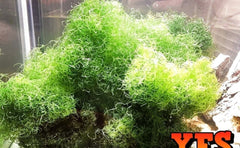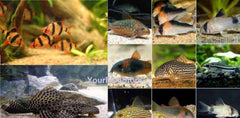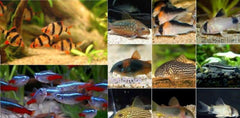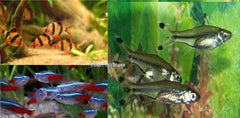X1 Silver Arowana Md/Lrg Fish 4" -5" + X10 Cichlids - Freshwater
Ebay
$ 161.54

x1 SILVER AROWANA MD/LRG 4" -5" + x10 CICHLIDS - FRESHWATER LIVE FISH
*This Package Include x10 Hand Pick Cichlids*
We will add a random x10 sm/md (1" - 2") cichlids to your order
The Silver Arowana (Osteoglossum bicirrhosum) is a long and beautiful fish known for its voracious appetite and constant surface skimming, looking for things to fit into its mouth. It is native to waterways of the Amazon River and other areas in South America.
It is a very popular fish for intermediate to expert aquarists as it swims fairly gracefully and with purpose and has a nice and powerful jaw. Aquarists like to watch it feed, especially live foods such as earthworms and other insects. A true carnivore, the silver arowana can be aggressive, especially toward smaller fish in the tank, so if you are going to keep an arowana with other fish, choose tankmates wisely. Fish that inhabit the middle and lower portion of the aquarium's water column are preferable.
The silver arowana's domain is near the surface, where it stays most of the time. The silver arowana is a visual hunter, and it has been observed in the wild jumping out of the water to snatch a hapless bug from an overhanging tree branch.
The silver arowana is not a beginner fish, but is more suitable for intermediate to advanced aquarists. It requires a large aquarium with strong filtration and a diet of primarily live foods such as feeder fish, earthworms and other insects. It will also eat floating foodsticks.
************************************************
For best results they should be provided with a highly varied diet. Shrimp, prawns, mealworms, crickets, centipedes, krill and frogs are all suitable foods, though any sharp pieces should first be removed and live animals should be quarantined first to avoid the introduction of parasites.
Arowanas enjoy eating smaller fish but should not be fed these too often, as a build-up of fat in their bodies can lead to health problems. Many arowanas will take pellet food, but this is not sufficient on a daily basis.
Individual preferences vary, so be ready to experiment to see what your arowanas like.
Because arowanas are so active and tend to swim fast, you should avoid having any sharp objects in your aquarium on which they might injure themselves. Fast flowing water will keep them in better condition as it will discourage them from rubbing against the glass.
Arowanas in aquariums often suffer from protruding, drooping eyes due to looking downwards a lot, which they should not do in the wild.
A good way to avoid this is to keep a brightly coloured ping pong ball floating on the surface of the water. This will distract them sufficiently to keep their eyes in good condition and they'll enjoy playing with it, giving you something extra to enjoy watching.
Arowanas are extremely difficult to breed in captivity, especially in an aquarium. They spend months courting to develop pair bonds and spawn just once a year. If they do breed successfully, the male will protect the eggs, and later the fry, in his mouth. However, the female may eat them, so it is best to separate her at this stage.
Customer Reviews
Based on 1 review
Write a review
QUESTIONS & ANSWERS
Have a Question?
Be the first to ask a question about this.














